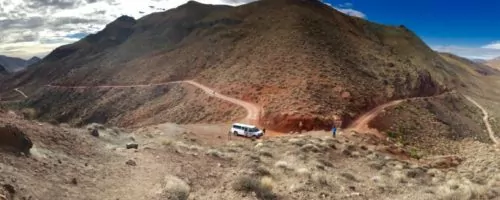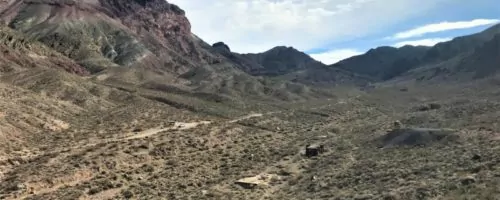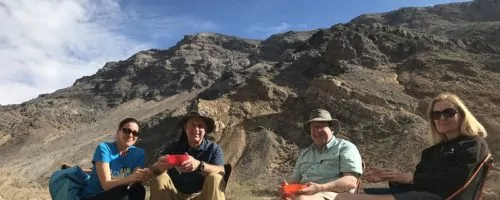
Titus Canyon
Titus Canyon is one of the deepest and most awe-inspiring canyons found in Death Valley National Park. If you’re up for an incredibly scenic backcountry road, drive the 27 mile Titus Canyon Road: a narrow, twisting, one-way thrill ride. A high clearance vehicle will take adventurers up to the vibrantly colored hills of Red Pass. From here, take a hike to nearby Thimble Peak or descend into the Leadfield ghost town. Beyond Leadfield lies the lush Klare Spring and ancient Native American Petroglyphs. No high clearance? No problem! Hikers can stroll up the 1.5 miles of Titus Canyon’s astounding narrows, which is only 20 feet wide and hundreds of feet deep in some places. Check out nearby Fall Canyon if you are looking to put in a few more miles of hiking. However you choose to explore, Titus Canyon is a must-do for any trip to Death Valley National Park.
Explore Death Valley with Expert Guides
the legend of Edgar Titus
In the summer of 1905, Edgar Titus and his brother-in-law Earle Weller arrived in Rhyolite, Nevada chasing the Bullfrog gold rush. Together with fellow prospector, John Mullan, they set off through the Grapevine Mountains with several burros loaded with prospecting equipment. After getting lost in the Grapevines, the men found a small seep with barely enough water to sustain even one man. Titus left the party in search of more water but never returned. The next day, Weller, too, went in search of his brother-in-law (and water.) Two weeks later, the third in the party, Mullan, was found barely clinging to life.
Titus met the fate of many who have died of heat exhaustion and thirst in this unforgiving landscape. All of his legacy that was found in the canyon were seven of his burros and a sign that read, “HURRY ON! I’M GOING DOWN TO INVESTIGATE THE SPRING.”

Must Do’s in Titus Canyon
Climb Thimble Peak
If you happen to be taking a drive on the amazing Titus Canyon Road, then why not take a break and bag an equally amazing peak. At just 5 miles round trip and a little over 1300 feet of total elevation gain, Thimble Peak is the best high return hike for minimal effort in Death Valley National Park. The trail begins on the south side of Red Pass (you’ll know when you get there). From here, follow the well-worn path up the ridgeline to the base of Thimble’s sheer limestone cliffs. It may initially look intimidating, but the path is a series of careful switchbacks straight up the northern ridge. From the summit, the outstanding views rival those from even Telescope Peak. Although it is a relatively tame hike, exercise extreme caution on the final approach as it involves some steep, loose, and partially exposed scrambles. Enjoy the view!
Explore the Ghost Town of Leadfield
Not much remains of the unincorporated mining town of Leadfield; just a legacy of one of the greatest examples of the fraud, deception, and deceit that ran rampant in the mining boom of Death Valley. It is said that C.C. Julian could have sold ice to an Eskimo. After blasting several prospecting holes and spiking them with lead ore he had purchased in Tonopah, NV, Julian wildly promoted the richness of the Leadfield mines. He had posters drawn of ships laden with lead ore steaming up the Amargosa River. (Never mind that the river was miles away and almost always completely dry by the time it got to Death Valley.) Prospectors and investors flocked to the area and in 1926, a US Post Office was built. Within 7 months, however, the mines played out and Leadfield died. The post office and a few other building remnants are all that remain.
Maximize Your Visit to Death Valley National Park on a Hiking Tour
Guided multi-day packages allow visitors the opportunity to make the most of their time in Death Valley National Park and to do it hassle-free. Guided tours include gear (backpack, trekking poles, crampons in winter), meals, accommodations, local transportation, and a professional Death Valley hiking guide. Through their knowledge, stories, and personal passion, guides can bring a place to life in a way that’s much more difficult to do on your own. Read more about Death Valley Hiking Tours.

Award Winning USA Hiking Vacations
3 Best Hikes Near Titus Canyon
A drive through the sublime Titus Canyon Road or a hike into the lower narrows are adventures in Death Valley that are not to be missed. Check out these other amazing nearby hikes to make the most of your Death Valley visit.
| Destination | Miles | Elev | Difficulty | Style | |
| Fall Canyon Trail | 6 mi | 1500 ft | Moderate | Out and Back | |
| Ubehebe Crater Trail | 0.5-2 mi | 300-1000 ft | Easy-Moderate | Out and Back | |
| Cottonwood-Marble Canyon Trail | 26-28 mi | 3800 ft | Strenuous | Loop |
1. Fall Canyon Trail
Easy access, gentle grade, and colorful canyon walls extending 2000 feet above make Fall Canyon an outstanding hike in Death Valley National Park. Dropping into the wide wash of Fall Canyon, you will immediately know that you are in for something big. Along the hike, the canyon walls display vibrant reds, whites, blacks, and greys of geologic strata uplifted at varying angles. Wind your way up the canyon, passing intriguing side canyons to the base of a 20-foot dry fall. For most, the adventure stops here. A short stroll back will reveal a short slope scramble to bypass the falls on the south side. Adventurous souls will be treated to a beautiful section of narrows above the dry fall. The stunning narrows of lower Titus Canyon are a great way to add on a few miles. Whatever you fancy, Fall Canyon is a sure bet for a great hike.
2. Ubehebe Crater Trail
Ubehebe Crater is a stunning testament to Death Valley’s violent volcanic past. At 600 feet deep and a half-mile across, Ubehebe is the largest of a series of craters that pockmark the area. Take a walk along the loop trail at the rim of the crater and explore several other smaller, more eroded craters. From the high point along the rim, observe the massive blanket of grey-black cinder; the result of Ubehebe’s eruption. Another great way to experience the enormity of Ubehebe is to take the short but steep trail to the bottom of the crater. Although the 600 feet of elevation gain to come back up doesn’t sound like much, it can seem twice as far when hiking up the steep, loose cinder trail. Hikers of all ages and abilities are sure to have a blast at Ubehebe Crater.
3. Cottonwood-Marble Canyon Trail
Hiking Cottonwood and Marble Canyons is the pinnacle of backpacking adventure in Death Valley National Park. This hike explores lush desert oases, ancient Native American petroglyphs, and some of the most astounding canyon narrows around. Lounge in the shade of a spring-fed cottonwood tree on a hike into Cottonwood Canyon. Hunt for ancient fossils and rock art in the masterfully sculpted narrows of Marble Canyon. The trail is not developed, so it requires good navigation skills. This is truly an unforgettable experience on the wild frontier of backpacking. Backpacking in Death Valley’s remote backcountry and arid climate should be approached with caution. Know your route and especially your water sources. Make this hike the one you remember for the rest of your life.
Join a Guided Death Valley National Park Backpacking Trip
Joining a Death Valley backpacking tour is a worry-free, adventurous way to experience Death Valley National Park. With your gear, meals, local transportation, permits, and fees taken care of for you, you can travel light and focus 100% on enjoying the hiking experience, while the guide company takes care of everything else. Also, by going with local experts you’ll enjoy a greater level of safety and gain a much better understanding of the history and ecology of this remarkable region. Read more about a guided Death Valley National Park backpacking trip.

When to Hike and Seasonal Considerations
Titus Canyon is accessible year-round. However, summer travel is not advised. Check weather and road conditions before you go. Titus Canyon is subject to flash flooding and the road is subject to closure after flooding events. The best time of year to visit is early fall to late spring.
Necessary Permits
Day Hikes
No permits are required for day hiking in Death Valley National Park.
Backpacking Permits
Backcountry camping permits are voluntary and may be obtained at the Visitor Center or any Ranger Station. Due to the extreme environment and remoteness, it is recommended that solo hikers and backpackers provide itinerary information and emergency contacts to park personnel.
Getting to Titus Canyon
Top-Down Drive:
From the Furnace Creek Visitor Center, take CA-190 W 11 miles to the junction with Beatty Road. Take a right on Beatty Road and drive another 10 miles to merge with Daylight Pass Road. The turnoff onto Titus Canyon Road will be on the left at 13.3 miles. From the town of Beatty, NV drive 6 miles on NV-374 S to the turnoff onto Titus Canyon Road on the right. From this point on, Titus Canyon Road is a 27-mile one-way drive. High clearance is highly recommended. Sections of this road are very steep and exposed, so exercise caution. Check road conditions before you go as the Titus Canyon Road is subject to closure after heavy rain events.
Bottom-Up Hike:
From the Furnace Creek Visitor Center, take CA-190 W 17 miles to the junction with Scotty’s Castle Road. Take a right onto Scotty’s Castle Road and drive 15 miles to Titus Canyon Road on the right. The 3-mile access road is a graded gravel road accessible by most vehicles. High clearance is recommended. The parking area is at the mouth of Titus Canyon. From here you can hike as far up the canyon as you would like. Just keep an eye out for oncoming traffic.
Suggested Packing List
Day Hike Packing List
- 3-4 liters of water per person
- Salty, calorie-rich snacks
- lunch
- backpack
- trekking poles
- crampons (in winter)
- wide-brimmed hat
- sunscreen, sunglasses
- cotton t-shirt (spring-fall)
- non-cotton t-shirt (winter)
- rain jacket
- warm non-cotton layer
- 1st-aid kit
Backpacking Packing List
- all items listed for day hikes PLUS
- additional water AND water filter/purification method
- multi-day backpack
- 3-season tent
- sleeping bag
- sleeping pad
- backpacking stove and fuel
- backpacking meals
- 2-3 pairs wool socks
- extra t-shirts
Please Respect Our National Parks – Leave No Trace
We strongly recommend abiding by all Leave No Trace ethics guidelines and practices so that our national parks and public lands are preserved for the enjoyment of future generations and for the people and animals who call these places home. Simple things like packing out your trash, obeying national park rules, and respecting the peace and quiet of our national park trails is a great start. If you’re going on a backpacking trip, you can read more about the 7 Leave No Trace Principles.




